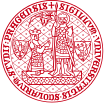


Institute of Formal and Applied Linguistics
Charles University, Czech Republic
Faculty of Mathematics and Physics
NomVallexDer
Word-formation Relations Reflected in Noun Valency: The Case of Czech Deverbal and Deadjectival Nouns
The project deals with both theoretical and lexicographic treatment of deep and surface aspects of noun valency. It focuses on nouns directly or indirectly motivated by the same verbs, namely on deverbal and deadjectival nouns. This approach makes it possible to examine to what extent these nouns share valency properties with their motivating verbs and thus verify the valency inheritance hypothesis. The project builds upon the valency theory of the Functional Generative Description. Starting with nouns already contained in the valency lexicon NomVallex, other nouns with the same motivating verbs are selected from DeriNet, a database of derivational relations in Czech. The theoretical issues addressed in the project will include systemic and nonsystemic valency behavior of these nouns, reciprocity, and changes in meaning and/or valency of a noun associated with using a negative prefix. Results from the research into the addressed language phenomena will be integrated in the NomVallex lexicon (version 2.5, see below) which will then form a solid basis for further theoretical research into noun valency.
NomVallex 2.5
NomVallex is a manually annotated valency lexicon of Czech nouns and adjectives, adopting the theoretical framework of Functional Generative Description as its theoretical basis. In total, NomVallex 2.5 comprises 1337 lexical units contained in 730 lexemes. As for derivational categories, it covers deverbal, deadjectival or denominal nouns, and deverbal, denominal, deadjectival or primary adjectives. Valency properties of a lexical unit are captured in a valency frame (modeled as a sequence of valency slots, each supplemented with a list of morphemic forms) and documented by corpus examples (extracted from the SYN series of corpora from the Czech National Corpus or from the Araneum Bohemicum Maximum corpus). To enable analysis of the relationship between the valency behavior of base words and their derivatives, lexical units of nouns and adjectives in NomVallex are linked to their respective base lexical units (contained either in NomVallex itself or, in the case of verbs, in the VALLEX lexicon), linking together up to three parts of speech (i.e., noun–verb, e.g., vnímání ‘perception’ – vnímat ‘perceive’, adjective–verb, e.g., vnímatelný ‘perceivable’ – vnímat ‘perceive’, noun–adjective, e.g., vnímavost ‘perceptiveness’ – vnímavý ‘perceptive’, and noun–adjective–verb, e.g., vnímavost ‘perceptiveness’ – vnímavý ‘perceptive’ – vnímat ‘perceive’). NomVallex 2.5 is an enhanced edition of the NomVallex 2.0 version; new developments that feature in the NomVallex 2.5 version include an increase in the number of noun and adjectival lexemes covered, treatment of negation (i.e., negative forms of nouns and adjectives), and annotation of reciprocity or reflexivity.
Publications
- Kolářová, V., Kettnerová, V., Klímová, J., Mírovský, J., Vernerová, A. (2024): NomVallex 2.5. LINDAT/CLARIAH-CZ digital library at the Institute of Formal and Applied Linguistics (ÚFAL), Faculty of Mathematics and Physics, Charles University, http://hdl.handle.net/11234/1-5826. Available at https://ufal.mff.cuni.cz/nomvallex/2.5.
- Kolářová, V. (2024): Active and passive syntax of Czech deverbal and deadjectival nouns. Lingua, 307 (2024) 103686, https://doi.org/10.1016/j.lingua.2024.103686.
- Kolářová, V., Mírovský, J. (2024): Looking for sense in nonsense: Valency of negative forms of nouns and adjectives in the NomVallex lexicon. In: Despot, K. Š., Ostroški Anić, A., Brač, I. (eds.): Lexicography and Semantics. Proceedings of the XXI EURALEX International Congress. Institut za hrvatski jezik, Zagreb, ISBN 978-953-7967-77-2, pp. 485-496.
- Kolářová, V. – Mírovský, J. (2024): Příbuzná deverbální a deadjektivní abstraktní substantiva ve valenčním slovníku NomVallex. In: I. Bozděchová, B. Niševa, K. Skwarska (eds.): Česká slovotvorná koncepce v kontextu slovanské jazykovědy. Monografie věnovaná 110. výročí narození a 20. výročí úmrtí Miloše Dokulila. Academia, Slovanský ústav AV ČR, Praha, pp. 263–274.
- Panevová, J. (2024): Paradigmatické a syntagmatické vztahy u vybraných slovesných adjektiv. In: I. Bozděchová, B. Niševa, K. Skwarska (eds.): Česká slovotvorná koncepce v kontextu slovanské jazykovědy. Monografie věnovaná 110. výročí narození a 20. výročí úmrtí Miloše Dokulila. Academia, Slovanský ústav AV ČR, Praha, pp. 147–154.
- Kolářová, V. – Kettnerová, V. – Mírovský, J. (2023): Through Derivational Relations to Valency of Non-verbal Predicates in the NomVallex Lexicon. Jazykovedný časopis, 74(1), pp. 182–192.
- Kettnerová, V. – Kolářová, V. (2023): K reciprocitě adjektiv v češtině. Slovo a slovesnost, 84(3), pp. 179–200.
- Kolářová Veronika, Vernerová Anna (2022): NomVallex: A Valency Lexicon of Czech Nouns and Adjectives. In: Proceedings of the 13th Conference on Language Resources and Evaluation (LREC 2022). European Language Resources Association, Marseille, France, ISBN 979-10-95546-72-6, pp. 1344-1352.
